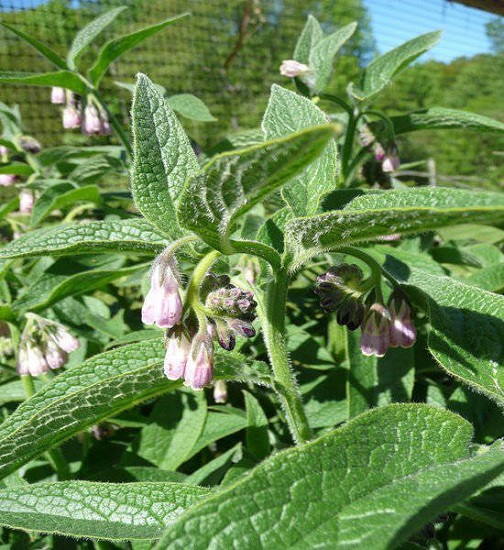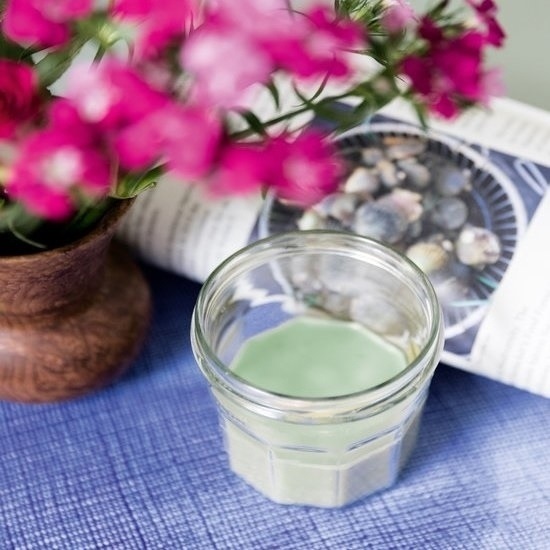
Native to Europe and Asia, comfrey, often called the “miracle plant,” is a rather attractive perennial herb with hairy or prickly stems and lance-shaped leaves. Comfrey’s small bell-shaped flowers grow in various colors, typically cream, pinkish, or purplish (depending on the specific variety of the plant), and the plant has dark-hued roots that extend quite deep into the ground.
Comfrey grows to approximately 3 feet tall. Its first reported medicinal use dates back to approximately 400 BCE. Latin in origin, the word comfrey means “to grow together,” leaving little speculation as to why Greek physicians often relied on the herb to treat inflammation, wounds, ulcers, gangrene, burns, fractures, and sprains.
As an herbalist, licensed holistic esthetician, professional aromatherapist, and certified reflexologist with an affinity for formulating products that are effective via topical application, comfrey is one of my go-to herbs — it has so many remedial uses. Comfrey-infused oil, available from better health food stores, herb shops, and online retailers such as Mountain Rose Herbs, is the base of the following recipe, which contains a key oil-soluble, pharmacologically-active constituent called rosemarinic acid.
Being a rather formidable polyphenol or antioxidant, rosemarinic acid boasts antimicrobial, anti-allergic, analgesic, and anti-inflammatory properties, plus it is gently astringent or tissue-tightening. Like Vitamin E, it may help prevent cellular damage within the skin and speed wound healing.
Applied topically on a regular basis, comfrey-infused oil offers pain relief for muscular soreness and stiffness, bruises, strains, sprains, achy or arthritic joints, and gout. Great for everyday achy hands and feet, too. In fact, I make my own comfrey leaf-infused oil and use it liberally with my clients in my foot and hand reflexology practice in Marble Falls, Texas. It comforts their sore, tired, stressed muscles, tendons, and ligaments and prevents my heavily-worked hands from barking at the end of my long day performing manual therapy.
-Advertisement-
Cooling Comfrey Balm Recipe

Photo by Mars Vilaubi (copyright 2018)
This is a gorgeously rich balm with the unusual spicy-sweet aroma of German chamomile, the cooling pop of peppermint, and the relaxing floral of lavender.
It counteracts the itch, redness, inflammation, and heat of most generic and poison plant rashes and is the ultimate soother for relieving pesky insect bites and stings. It calms and comforts irritated skin tissue and encourages healing. Plus, it’s incredibly beneficial for conditions such as minor burns or sunburn, cuts and scrapes, scars and stretch marks less than two years old, dry eczema and psoriasis that is accompanied by itching, peeling, flaking skin, and dry, cracked, chapped, or fissured skin.
I often reach for this beautiful, aromatic balm at the end of the day, right before retiring — massaging it anywhere achiness and irritation reside. The scent lulls me to sleep and my discomforts fade away. Ahhh!
Make yourself a batch or two, won’t you? This recipe is also perfect for gift-giving — design a decorative custom label with directions, ingredients, and date made. I don’t know anyone who wouldn’t want a jar for their natural medicine cabinet. It’ll come in handy year ‘round.
Recipe notes: Safe for folks 6 years of age and older. For children aged 2 to 5, reduce the essential oils by half. Do not use on deep cuts or puncture wounds (a seeming contradiction), as comfrey oil may stimulate the outer layer of skin tissue to mend and seal the wound before regeneration of deeper subsurface tissues, which could result in an internal infection. Use balm after the wound has significantly closed.
Ingredients:
-Advertisement-
Yields approximately 4 ounces (120 ml), or ½ cup
- 10 drops German chamomile (Matricaria recutita) essential oil
- 10 drops peppermint (Mentha piperita) essential oil
- 4 drops lavender (Lavandula angustifolia) essential oil
- 7 tablespoons comfrey-infused oil
- 1 to 2 tablespoons beeswax pastilles or flakes (use the greater amount for a firmer balm)
- One 4-ounce dark glass or plastic jar
Directions:
1. Combine the comfrey oil with the beeswax in a very small saucepan over low heat, or in a double boiler, and warm until the beeswax is just melted. Remove from the heat and allow to cool for 5 minutes, stirring a few times.
2. Add the German chamomile, peppermint, and lavender essential oils and stir again to thoroughly blend.
3. Slowly pour the liquid balm into the jar. Cap, label, and set aside for 30 minutes to thicken. No refrigeration is required. Store at room temperature, way from heat and light. Use within 1 year.
How to Use Comfrey Balm for Healing
A little goes a long way, keep this in mind! For irritated, rashy, hot, inflamed, sunburned skin or insect bites, first wash the affected area with mild soap and cool water. Pat dry. Massage a small amount of balm onto the area and surrounding skin. Continue twice daily until irritated area has healed.
For aches, pains, bruises, strains, sprains, cracked skin, and minor skin burns that have cooled, apply a small amount as needed up to three times per day.
-Advertisement-
Recipe excerpted from Stephanie Tourles’s Essential Oils: A Beginner’s Guide (available in the Mother Earth News Store). Used with permission from Storey Publishing.
Stephanie Tourles is a licensed holistic aesthetician, certified aromatherapist, and gardener with training in Western and Ayurvedic herbalism. She has also written many other books, including her best-selling Organic Body Care Recipes; Hands-On Healing Remedies; Raw Energy In a Glass; Raw Energy; Pure Skin Care; Stephanie Tourles’s Essential Oils; and Naturally Bug-Free (all available in the MOTHER EARTH NEWS Store). Visit her website to learn more, and read all of her MOTHER EARTH NEWS posts here.
All MOTHER EARTH NEWS community bloggers have agreed to follow our Blogging Guidelines, and they are responsible for the accuracy of their posts.


